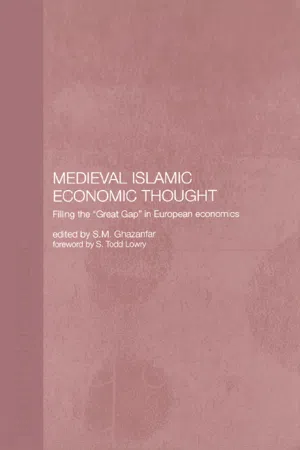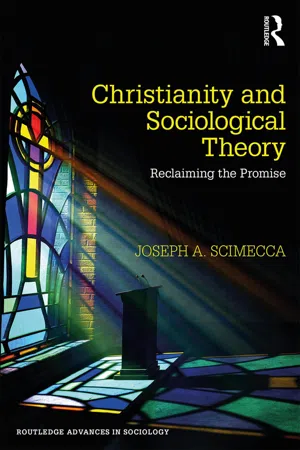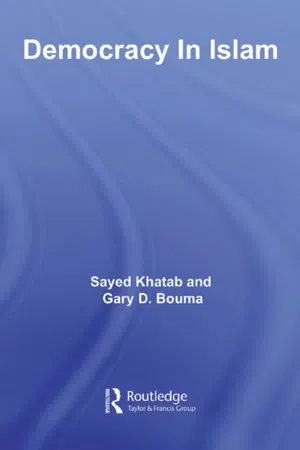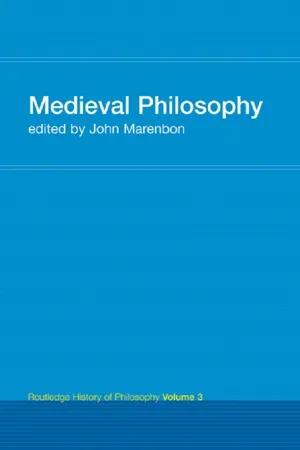History
Scholasticism and Arabian Influence
Scholasticism refers to the medieval philosophical and theological system that sought to reconcile faith and reason. It was heavily influenced by the works of Arabian philosophers, particularly Avicenna and Averroes, who introduced Greek philosophy to the Islamic world. This influence led to the incorporation of Aristotelian thought into Christian theology, shaping the intellectual landscape of medieval Europe.
Written by Perlego with AI-assistance
Related key terms
6 Key excerpts on "Scholasticism and Arabian Influence"
- eBook - ePub
Medieval Islamic Economic Thought
Filling the Great Gap in European Economics
- S.M. Ghazanfar(Author)
- 2004(Publication Date)
- Routledge(Publisher)
Further, we can readily agree on the more recent Western impact on the Islamic world, for not only we are our witnesses, but also because of the long-established Western superiority that we take for granted. However, it becomes somewhat unsettling when we learn of the distant, far more significant impacts in reverse. Once the initial reaction is overcome, the tendency then is to keep the extent of those impacts within “proper bounds”. The names of a few medieval Islamic scholars are tolerated, but, at best, we begrudge them a role beyond mere “transmitters” of the Greeks (see Makdisi 1974). Such posturing is “garbled falsification” and “colossal misrepresentation” (Briffault, 189, 201), and “worse than a lie” (Sarton 1952, 27).Having stated a secondary but related theme of this paper, we now proceed to the main task: that is, to document some evidence as to the influence of selected Arab-Islamic Scholastics, Ibn Rushd in particular, which contributed immeasurably to European awakening.The Islamic Scholastics and their influence
Presently our task is to briefly explore the intellectual core of the medieval Islamic-European connections that gave rise to what Haskins called the “vision of a profoundly secular renaissance” (quote from Benson and Constable, xxiii). That vision was inspired through the scholarship of medieval Islamic “giants”, as Sarton referred to them, such as those mentioned earlier—Al-Kindi (801–73), Al-Razi (865–925), Al-Farabi (870–950), Ibn Sina (980–1037), Al-Ghazali (1058–1111), and, in particular, Ibn Rushd (1126–98). The Europe of the late Dark Ages was receptive, but such a visionhad no roots in the earlier medieval culture of the West. It is neither Christian, nor Latin, nor German. It appears abruptly in Southern France about the time of the First Crusade, without any preparation and previous development…The origins of the new style are to be found in the rich and brilliant society of Muslim Spain.(Dawson 1952, 153)Thus emerged the “confidence in the power of reason and that faith in the rationality of the universe without which science will have been impossible” (Dawson 1967, 230). The period of the Crusades provided the “greatest stimulus to cultural advance” through “challenges from the outside, as Western Europeans expanded their horizons and discovered the very different peoples who lived beyond their frontiers” (Ferruolo, 136). Further, “the Crusades were of central importance…they helped to shape European attitudes, feelings, and values. The achievements of the twelfth century renaissance owe a great deal to the Crusades” (Ferruolo, 137). - eBook - ePub
Medieval Philosophy
From 500 CE to 1500 CE
- Britannica Educational Publishing, Brian Duignan(Authors)
- 2010(Publication Date)
- Britannica Educational Publishing(Publisher)
HAPTER 4THE AGE OF THE SCHOOLMENW hile Western scholars were assimilating the treasures of Greek, Arabic, and Jewish thought, the universities that would become the centres of Scholasticism were being founded. Of these, the most important were located in Paris and Oxford (formed 1150–70 and 1168, respectively). “Scholasticism” is the name given to the theological and philosophical teachings of the Schoolmen in the universities. There was no single Scholastic doctrine, however, and for this reason it is difficult to define Scholastic philosophy beyond the generalization just offered. Each of the Scholastics developed his own doctrine, which was often in disagreement with that of his fellow teachers. They had in common a respect for the great writers of old, such as the Church Fathers, Aristotle, Plato, Boethius, Pseudo-Dionysius, Avicenna, and Averroës. These they called “authorities.” Their interpretation and evaluation of the authorities, however, frequently differed. They also shared a common style and method that developed out of the teaching practices in the universities. Teaching was done by lecture and disputation (a formal debate). A lecture consisted of the reading of a prescribed text followed by the teacher’s commentary on it. Masters also held disputations in which the affirmative and negative sides of a question were thoroughly argued by students and teacher before the latter resolved the problem.This map shows Europe’s universities during the Medieval era. From The Historical Atlas by William R. Sheperd, 1923 . Courtesy of the University of Texas Libraries, The University of Texas at AustinTHE NATURE OF SCHOLASTIC PHILOSOPHY
Scholasticism was so much a many-sided phenomenon that in spite of intensive research, scholars continue to differ considerably in their understanding of the term and in the emphases that they place on individual aspects of the phenomenon. Despite this lack of consensus, it is possible to provide a reasonably good characterization of the nature of Scholastic philosophy in general terms. - eBook - ePub
- Julian Marias(Author)
- 2012(Publication Date)
- Dover Publications(Publisher)
195. THE SPIRITUAL WORLD OF THE THIRTEENTH CENTURY
THE REAPPEARANCE OF ARISTOTLE. The thirteenth century marks a new phase of philosophy. In its early stages Christianity had to confront Greek thought, and this necessity arises once again under somewhat different circumstances in the Middle Ages. Up until this time Christian philosophy had been constructed on the basis of a few Greek writings of Platonic or Neoplatonic character; in the thirteenth century the thought of the greatest of the Greek philosophers bursts forth in the West, and Scholasticism has to take into account this marvelously profound and acute philosophy which comes to it by way of the Arabs and which is different from anything in its own philosophic tradition. Christian philosophy passes through a stage in which Aristotelian thought is assimilated; this task is accomplished primarily by St. Albertus Magnus and St. Thomas Aquinas. This effort enormously enriches the possibilities of Scholasticism, but at the same time it leads Christian philosophy away from paths down which its original nature might have taken it. In any case, Aristotle’s appearance signals the arrival of a new and extremely fruitful era.A large and important role in this labor of assimilation falls to Spain. Ever since the twelfth century there had been intense activity in Spain in the field of translation; the school of translators in Toledo which was founded by the Archbishop Don Raimundo deserves special mention because it was one of the most active centers in all of Europe. Arabic and Jewish books were translated: the works of Alfarabi, Al-Gazel, Avicenna, Avicebron; later, the Arabs bring to the West their translations of Aristotle, which are translated into Castilian and then into Latin or else directly into Latin. The most important of these translators was Gundisalvus, or Dominicus Gundisalvus, sometimes mistakenly called Gundissalinus, the author of a philosophical encyclopedia of Aristotelian character entitled De divisione philosophiae and a treatise called De immortalitate animae. - eBook - ePub
Christianity and Sociological Theory
Reclaiming the Promise
- Joseph A. Scimecca(Author)
- 2018(Publication Date)
- Routledge(Publisher)
Although the Middle Ages are often referred to as the “Age of Faith,” contrasting it to the Enlightenment (which is also known as the “Age of Reason”), this is much too simplistic a description of either era. Somewhat forgotten is that the Scholastics, for “over four centuries or more placed a heavy reliance on reason.” Moreover, “in the history of civilization, they were the first to do so self-consciously on a grand scale” (Grant 2001:7–8). Reason, for the Scholastics, was the key to understanding a rational universe created by a just God, one who created His subjects in His image and endowed them with reason in order for them to come to know Him. There was no conflict between faith and reason for the Scholastics because they believed that “revelation” as found in Scripture would in the end always lead to the support of faith. They believed that if they used their God-given reason, they would not arrive at conclusions contrary to faith. Although this viewpoint could seemingly raise problems concerning whether one was using “right reason,” it did not restrict the development of science because individual Scholastics never saw science as a threat to their theistic worldview. According to historian of science, David Lindberg (2007:218), by formalizing reason as a means to achieve understanding and knowledge and institutionalizing this vision in the medieval universities that were just coming into existence, the Scholastics played “a vital role in promoting the natural sciences.” This institutionalization of reason arguably is the primary reason why science emerged in Christianized Europe and not anywhere else.The emphasis on reason also allowed medieval scholars to eventually separate theology from philosophy. When the “natural philosophy” of Aristotle (384 bc –322 bc ), which included what we know today as physics and biology, was rediscovered in the twelfth century via the translations of the Muslim scholar, Ibn Roschd, or as he is generally known, Averroes (1126–1198), the workings of nature became subject to reasoned investigation. Natural philosophy was used to understand the regularities of nature.By the middle of the twelfth century, Aristotle began to replace his teacher, Plato (427 bc –347 bc - eBook - ePub
- Sayed Khatab, Gary D. Bouma(Authors)
- 2007(Publication Date)
- Routledge(Publisher)
80 Albert’s pupil, Thomas Aquinas (1227–1274) attempted to bring Aristotle under the rubric of Church ecclesiology, through his theo-philosophical interpretation of Muslim philosophy such as that of al-Kindi and Ibn Sina. The Franciscan Roger Bacon (1214–1294), relied heavily on Muslim thought and made important contributions in the fields of natural sciences, law and mathematics.Both the scholastics and the scholars of the Renaissance period owed a great debt to Muslim thought. Ibn al-Haytham is well known in the West as philosopher, physicist and mathematician, and is usually referred to as ‘Alhazen’. Roger Bacon refers to him frequently.81Ibn al-Haytham’s optical treatise Kitab al-Manazir was written in Cairo before 1039, and translated by Gerard of Cremona and later by a few other European philosophers. This multivolume opus is ‘widely recognised as the most complete and most advanced work on its subject. This work became the major source of the extensive and subsequently influential writings on light and vision by Roger Bacon, Witelo and John Pecham.’82 The text attracted the attention of Renaissance philosophers and artists including ‘Lorenzo Ghiberti’. In 1572 Friedrich Risner translated the book and appeared in Basel. This translation, ‘thanks to the edition, the Perspectiva’, now called Alhazeni Optica, became more easily and more directly accessible to mathematics in the late sixteenth and seventeenth centuries, such as Willebrord Snellius, Johannes Kepler, Rene Descartes, Issac Barrow, Rene Francois de Sluse and Christiaan Huygens. All of these made substantial use of the various parts of the book, particularly its sophisticated mathematical treatment of optical problems. The book’s contribution was not only to medieval sciences and mathematics but also to modern aspects of these fields, as emphasised and fruitfully examined by Vasco Ronchi, David C. Lindberg and Graziella Federici Vescovini (1965), to mention only a few.83 - eBook - ePub
Routledge History of Philosophy Volume III
Medieval Philosophy
- John Marenbon(Author)
- 2003(Publication Date)
- Routledge(Publisher)
CHAPTER 8 The intellectual context of later medieval philosophy: universities, Aristotle, arts, theology
Stephen BrownORIGIN OF THE UNIVERSITIES
A number of medieval towns in the twelfth century owed a large portion of their renown to their schools. Chartres was both respected and criticized for its efforts to reconcile Plato and Aristotle. Reims was a centre for the study of Scripture and the Fathers. Anselm of Laon brought fame to his home as a centre of developing theology. Paris was a magnet attracting famous teachers: Abelard, the dialectician and theologian; Hugh, Richard, and Andrew of St Victor, who brought to their Parisian abbey a justly respected name in the study of Scripture and a reverential awe for its level of mysticism; and Peter Lombard, whose Sentences became, from the thirteenth to the sixteenth century, the ordinary textbook of theology. Toledo's cathedral school became a place of contact between the Christian and Muslim intellectual worlds and offered a home for translators and commentators. In that school Dominic Gundissalinus, Gerard of Cremona, the Scotsman Michael Scotus, and the Englishman Alfred of Sareschal provided translations of Aristotle and his Islamic commentators that would later serve as key curriculum texts in the nascent universities.1 Bologna grew famous for the study of law, owing mainly to the stature of the legal advisers of Frederick Barbarossa and to the masters who explained Gratian's great canonical collection, the Decretum . Salerno drew students for medicine owing to the fame of Constantine the African, translator of the Articelli or Art of Medicine
Index pages curate the most relevant extracts from our library of academic textbooks. They’ve been created using an in-house natural language model (NLM), each adding context and meaning to key research topics.





